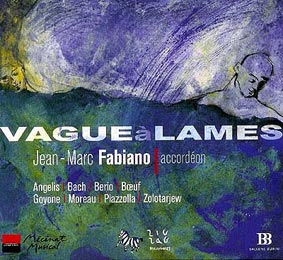 VAGUE
A LAMES VAGUE
A LAMESA valuable French accordionist succeeds to " place " an excellent disk for a prestigious record label (Zig Zag Territoires " who is a partner of the Société Générale Mécénat Musical, institution of national level) with a wordlwide distribution (Harmonia Mundi). This chain of disks can vant itself a collaboration with famous painters that are initalising their works destinated to cover the booklets (in this special case we are talking about the painter Anne Peultier) that introduces texts in French, English and German language. Even the content of the texts displays a different style: not the usual list of biography that includes composers and performers, but an interview among a composer ( Jean-Pierre Moreau ) of one of the " new " works especially written for this disk and the interpreter; an interview that eviscerates more the CD/interprete/motivation relationship than the usual historical evolutionism, or much less the fairytails on the " endless " concert abilities of the accordion. So, a disk that introduces itself in a " different " way with a series of interpretations on a " differented level ". The scene of concertisme , the scene of someone that has a consolidated relationship with the public and escaping the stunts and the impetus of having to demonstrate things to others. This is gathered in the thoughtlessness and the joy of the passage of the piece Goyone, in the superb search of unsaid "words" and the network of the sequence of Berio, in the nonconformist execution and the very eloquent piece "Partita" of Zolotariov. In a known passage and even vast piece like the "Partita ", Fabiano is looking with every measure to display different aspects, there is an analysis ( in this case much emotional, instinctive ) of the semantic possibility of the passage. Just as in the piece of Angelis there is the exaltation of the accordion as rhythmic instrument and in the piece Ciaccona as passionate instrument ( a real joy for Fabiano having inserted these passages…) These "creations" being the first part of the CD and are also the highlights of it. Jean-Pierre Moreau re-arranged Ave Maria of Piazzolla in an - for sure - amazing way. I find this arrangement much more accordionistic (appropriate for the accordion ) than many other versions for solo-instruments that I have had the opportunity to listen to. An execution with more instruments would be a different thing, but taking this example of performance for a solo-accordion seems to me being an excellent choice. The composer of this passage - Moreau has intitled it with a wisdom of life ( the freedom begins there where it ends … ) and the interpreter performs this piece of music with the same determination and principle: a vigorous and peremptory passage, a severe interpretation and define living. The other creation is "Mots croisés" of Georges Bœuf a passage that explores in the first part an interesting sound (timbro) of the accordion in the diverged heights (acuto) ; a very unusual attitude showing that today's composers often abandon themselves for extremities, to the contrary Bœuf. He seems being struck by the transformation of the timbre (sound) ( of both manuals ) in various heights (octaves). Also the second part show an unusual way- the middle register with a series of sonorous mutants. All these features transform this recording into a high standard CD - from the project to its realization ( with the first executions to enrich it ) we are sure of it and thank Harmonia Mundi-for its diffusio Reviewed by Paolo Picchio. |